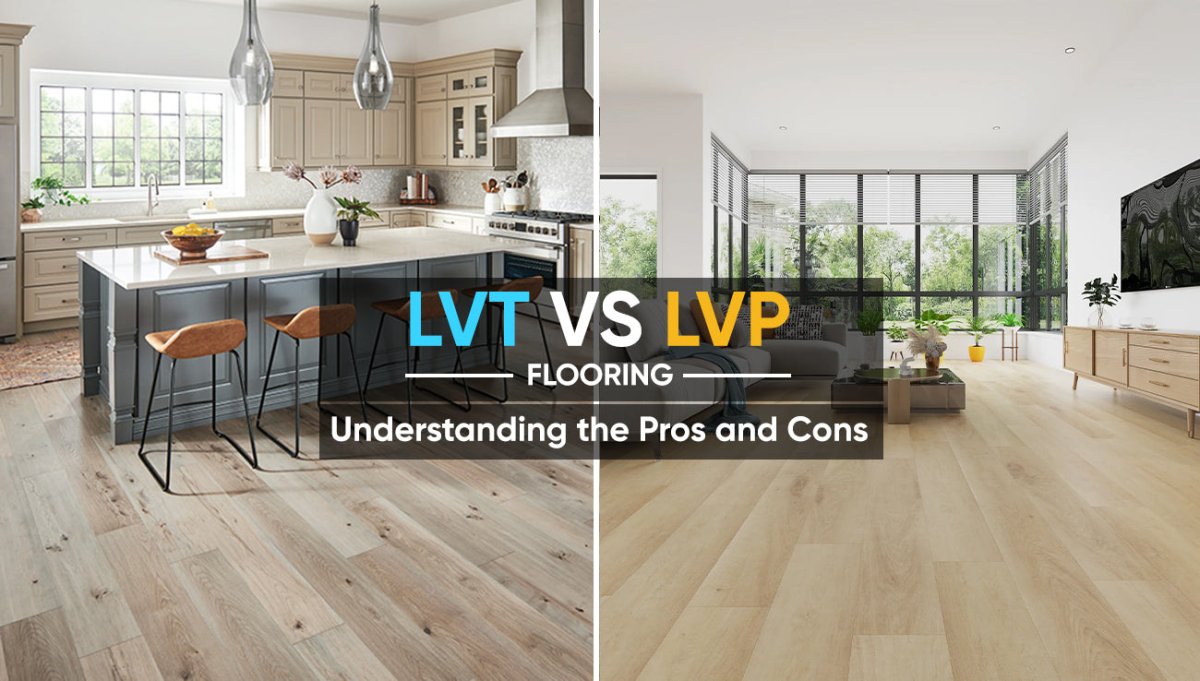Do the options seem a little overwhelming when it comes to choosing the perfect flooring for your home? You are not alone! To offer you some understanding of these two amazing flooring solutions, we're going to delve into luxury vinyl plank vs luxury vinyl tile. Join us as we discuss LVT vs LVP flooring in detail, including their definitions, differences, benefits, and drawbacks to help you decide which is ideal for your situation. Now, let's go forward:
What is LVT?
LVT stands for Luxury Vinyl Tile. Although it seems like real stone or ceramic tile, this style of flooring is really made of vinyl. This suggests that handling and installing it is much easier than with the real thing. It is especially popular in kitchens and bathrooms. It has a sturdy design that can tolerate high foot traffic and its tolerance for spills and splashes.
What is LVP?
LVP stands for Luxury Vinyl Plank Flooring. The main goal of this one is to give you the appearance of a hardwood floor without the hassles of actual wood. It is similarly composed of vinyl and is packaged in lengthy "planks" or strips that snap together. Because of its strength, ease of cleaning, and ability to withstand moisture, many people use it in basements and other spaces where genuine wood would be too risky to install.
Differences Between LVT and LVP

Appearance and Design
LVT: Fakes the appearance of stone or ceramic tiles, among other hard surfaces. Usually square or rectangular tiles, it comes in a variety of sizes and forms.
LVP: Designed to mimic hardwood floors, these lengthy planks have realistic textures and patterns of wood grain.
Format and Construction
Both LVT and LVP consist of multiple layers including a backing layer, a print layer (for the design), and a wear layer on top for protection. The primary difference in the format:
LVT: Often comes in individual tiles. The edges and surface might be textured to enhance the stone or tile effect.
LVP: Usually manufactured in planks, the dimensions of which are designed to replicate wooden boards.
Typical Use
LVT: Perfect for spaces that need the visual appeal of tile but also need extra toughness and water resistance. Frequently utilized in restrooms, kitchens, and business areas where a sleek, clean appearance is needed.
LVP: Favored in domestic spaces where the traditional appearance of wood is desired, such as living rooms, bedrooms, and corridors.
It’s also used in commercial settings that seek a warm, inviting ambiance.
Installation
Both types can often be installed using similar methods (glue-down, click-together, or loose lay), but the choice between LVT and LVP may also influence the installation pattern (e.g., staggered like bricks for LVT tiles or in rows for LVP planks).
Feel and Comfort
LVT: Can be colder and harder underfoot, similar to traditional tiles. It’s less forgiving in areas where you might stand for long periods, like kitchens.
LVP: Tends to be warmer and can feel softer underfoot, offering a slight give that is similar to wood, which can be more comfortable in living areas.
Choosing between LVP vs LVT flooring will largely depend on the desired look, the specific needs of the space, and personal preferences regarding style and comfort.
Pros and Cons of LVT
Pros:
- Lots of Styles: You can find LVT in all sorts of looks, from ones that mimic fancy stone to simple ceramic tiles.
- Tough Stuff: It stands up really well against scratches and spills, making it great for busy spots or places where kids and pets run wild.
- Waterproof: Suitable for bathrooms and kitchens, you don't have to worry about spills because water won't harm it.
- Easy to Maintain: Simply mop it occasionally and sweep it up.
- No need for fancy cleaners.
- Feels Okay on Your Feet: It’s not as hard as real tile, so it's a bit more comfortable to stand on.
Cons:
- Can Get Cold: Just like tile, it doesn’t hold heat well, so it might be chilly on your feet in winter.
- Slippery When Wet: You have to be careful after mopping or if something spills because it can get slick.
- Noise: It doesn’t do much to muffle sounds, so you might hear more echoes or footsteps, especially in a busy house.
Pros and Cons of LVP
Pros:
Looks Like Wood: Between luxury vinyl tile vs plank, LVP gives you that warm, cozy look of wood floors without the hassle. There are a bunch of different styles, too.
Sturdy and robust: It can withstand spills and scratches, which is ideal for high-traffic areas.
Deals with Wetness: Well, you don't have to worry about LVP warping in wet areas like bathrooms or basements as you would with genuine wood.
DIY Friendly: Many types come with a simple click-together setup that you can do yourself, no glue or nails needed.
Comfortable: It’s generally warmer and softer underfoot than other hard floors, which is nice when you’re walking around at home.
Cons:
May Fade in the Sun: Over time, the color might begin to fade if it receives a lot of direct sunshine.
Be Wary of Dents: If you're not cautious, heavy furniture or devices might leave marks.
Varying in Price: When considering LVT vs LVP cost, although they are extremely beautiful, premium floors might be quite costly.
Which is better: LVT vs LVP flooring?
Luxury Vinyl Plank (LVP) vs Luxury Vinyl Tile (LVT) selection mostly relies on desired style and intended use. Go for LVP if you want the warm, wood-like feel. Living rooms and bedrooms are good places for it to function. LVT is the perfect choice if you need a material that can tolerate moisture and spills in places like your kitchen or bathroom. These types are robust, easy to maintain, and straightforward. Just pick a look out of LVT vs LVP that you like to make the most of your environment and your own preferences.





